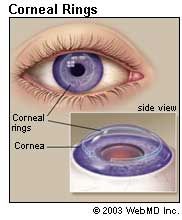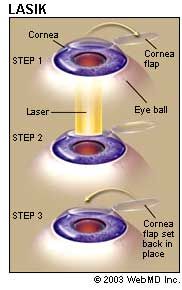Laser eye surgery is a surgery in which a laser reshapes the cornea to improve vision.


As we learned in 13.6, the cornea of the eye is a transparent bulge in top of the eye that causes light to converge. The lens also causes light to converge, though the converging in mainly done through the cornea.

Vision problems can occur when you have a weak lens-cornea combination that is too weak or a lens-cornea combination that is too strong. The problems are hyperopia (far-sightedness) and myopia (near-sightedness). These two problems occur when light from objects focus behind the retina or in front of the retina instead of at the retina. Thus a person with hyperopia or myopia can't focus on objects at every distance.
Laser eye surgery is also used to correct the vision of those who have astigmatism. Astigmatism is an eye condition in which your eye is not completely round creating refractive errors. You can click here for more information on astigmatism as we haven't talked about it in class.
Recently laser eye surgery has also been used to correct presbyopia, an eye condition which is a normal part of aging and makes focusing on near by objects difficult.
The Excimer laser is most often used for the procedure. This laser produces a ultraviolet light that vaporizes tissue, thus altering the shape of the cornea.
There are different types of laser eye procedure a person can have done. LASIK (Laser Assisted in situ Keratomileusis) and PRK (Photo-Refractive Keractectomy) are the most commonly used laser eye procedures in Canada. Two other more recent procedures are LASEK (Laser Epithelial Keratomileusis) and Epi-LASIK.
In all procedures the outer layer of the cornea, called the epithelium, or a flap of the cornea is cut and the laser removes enough tissue to reshape the cornea. The flap is then placed back where it previously sat. Depending on the procedure it can take 1-2 weeks to heal (less if you use LASIK).
There are some risks to laser eye surgery. These risks vary depending on the procedure used. Risks include:
- Pain
- Hazy Vision
- Dry Eyes
- A poor quality of night vision
- Corneal Ectasia
- Regression
- Corneal Infection
What people don't realise is that getting laser eye surgery does not permanently erase your need for glasses or contacts as your eyes change as you grow older.
For more information click here.
Even though laser eye surgery poses many risks there is said to be a success rate of 95%.
If you are interested in how the procedure takes place than you can click here (LASIK) or here (PRK). You can also watch the real life experience of two people undergoing LASIK eye surgery here (turn on annotations) and here. If you are interested in the side effects of laser eye surgery you can click here to watch a video of someone who believes that they were tricked into getting the procedure and are now adamantly against it (note: he quite obviously didn't do his research).



.jpg)
.jpg)


.jpg)

.jpg)
.jpg)

.jpg)


.jpg)








